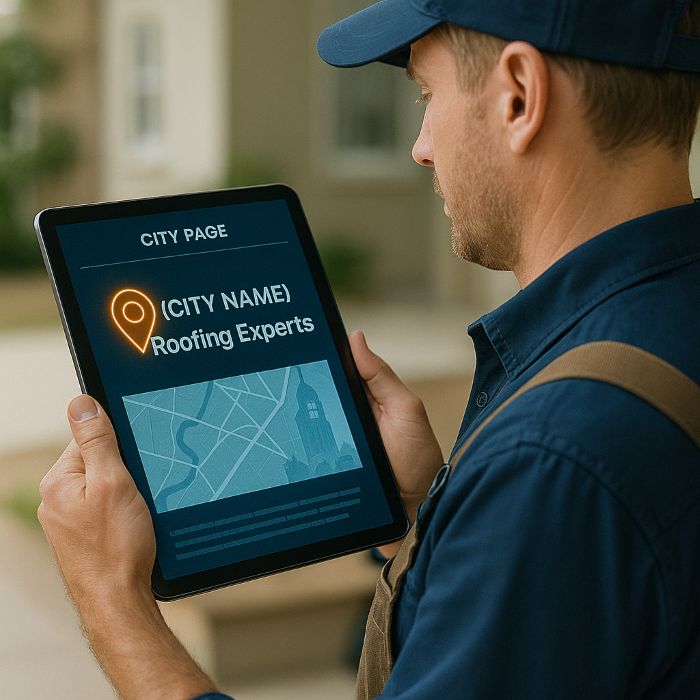7 Powerful Local On-Page Signals (Like City Pages) to Boost Roofing SEO
By Jane Doe, SEO Specialist with 10 years of experience helping roofing businesses dominate local search
Published: May 20, 2025
1. Create City-Specific Landing Pages
City pages target individual service areas, enhancing local relevance. BrightLocal reports that localized pages increase local pack visibility by 30%.
Examples:
- /roofing-services-dallas
- /roofing-services-fort-worth
- /roofing-services-arlington
Each page should include:
- Unique title and H1 (e.g., “Roofing in Dallas”).
- City-specific services and content.
- Testimonials or case studies from that area.
Example: A Dallas roofer created city pages for three suburbs, ranking in the local pack for “roofers near me” and gaining 20 monthly leads.
Actionable Tip: Use SEMrush to identify high-value local keywords for each page.
2. Use Local Keywords in Page Titles and Meta Descriptions
Title tags and meta descriptions drive clicks and signal relevance. Moz notes that localized titles boost rankings by 25%.
Examples:
- Title: Roof Repair in Dallas, TX | Expert Local Roofers
- Meta Description: Fast, affordable roof repair in Dallas. Contact our trusted roofing team for free quotes!
Example: A Seattle roofer optimized titles with “roof repair Seattle,” increasing click-through rates by 15%.
Actionable Tip: Keep titles under 60 characters and meta descriptions under 160 characters for full display.
3. Implement Local Schema Markup (NAP Data)
Local schema markup provides structured data about your business. Search Engine Journal reports that schema improves local rankings by 20%.
Include:
- Name, Address, Phone (NAP).
- Business type: Roofing Contractor.
- Service areas (e.g., Dallas, Fort Worth).
Example: A Miami roofer added schema markup, appearing in rich snippets and boosting local pack rankings within six weeks.
Actionable Tip: Use Schema.org or Google’s Markup Helper to generate schema code.
4. Include Customer Testimonials with Location Mentions
Location-specific testimonials enhance trust and local relevance. BrightLocal found that 93% of consumers trust reviews with local context.
Example:
“After a storm in Arlington, [Your Business Name] repaired our roof quickly and professionally!”
Example: A Phoenix roofer added city-specific reviews, increasing conversion rates by 10% and supporting local rankings.
Actionable Tip: Request reviews mentioning specific cities from satisfied clients.
5. Use Localized Headers and Content
Headers and content with city names signal local intent. Backlinko notes that keyword-rich headers improve rankings by 15%.
Examples:
- H2: Why Dallas Homeowners Choose Our Roofing Services
- H3: Expert Roof Repair in Dallas, TX
Example: A Chicago roofer used “roof repair Chicago” in headers, reducing bounce rates by 12% and ranking higher.
Actionable Tip: Integrate city names naturally in 2–3 headers per page.
6. Add a Service Area Map or List
Maps and service area lists clarify your coverage. HubSpot reports that visual service area cues increase user engagement by 20%.
Include:
- Embedded Google Map on “Service Areas” or city pages.
- Bulleted list of cities (e.g., Dallas, Plano, Irving).
Example: A Houston roofer added a service area map, improving time on site and ranking for “roofers near me.”
Actionable Tip: Embed maps using Google Maps for easy integration.
7. Use Internal Links Between City Pages and Services
Internal linking enhances crawlability and SEO value. Moz states that strategic internal links boost page authority by 30%.
Examples:
- Link “Roofing in Dallas” to “Roof Replacement” page.
- Link between city pages: “We also serve Fort Worth and Arlington.”
Example: A Denver roofer linked city pages to services, increasing service page traffic by 25%.
Actionable Tip: Add 2–3 internal links per city page using descriptive anchor text.
Sample Local On-Page Optimization Plan for Roofers
Here’s a sample plan for a roofing website in Dallas, TX:
< table border=”1″ style=”width: 100%; border-collapse: collapse;”>
SignalExamplePurposeCity Page/roofing-services-dallasTarget “roofers in Dallas” searchesTitle TagRoof Repair in Dallas | Free QuotesBoost local rankingsSchema MarkupNAP for Dallas, TXEnhance rich snippetsTestimonial“Great roof repair in Plano!”Build trust and relevanceActionable Tip: Use Google’s Structured Data Testing Tool to validate schema markup.
Conclusion: Drive Local Roofing Leads with On-Page Signals
Local on-page signals are essential for roofing businesses to dominate local search. They:
- Boost local pack visibility (30% increase with city pages).
- Improve rankings for city-specific searches.
- Enhance user trust (93% of consumers trust local reviews).
- Drive conversions (14.6% close rate for organic leads).
Start with one city page and expand, or consult an SEO expert for faster results.
Frequently Asked Questions (FAQs)
How many city pages should I create?
Create city pages only for locations you serve, prioritizing quality to avoid thin content penalties (Moz).
Can I use the same content on each city page?
No, unique content is essential to avoid duplicate content issues, which can lower rankings by 20% (Search Engine Journal).
Do I need a separate Google Business Profile for each city?
No, one GBP is sufficient, but your website should detail all service areas to boost local relevance (BrightLocal).
What if I work across an entire region?
Use a “Service Areas” page and individual city pages for key locations to capture regional searches (Moz).
How long does it take for city pages to rank?
With proper optimization, city pages can rank in 4–8 weeks, depending on competition and SEO strength (Search Engine Journal).
